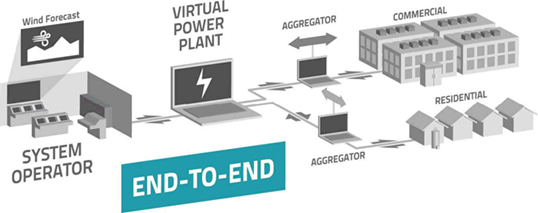- Distributed Energy Resources
- Energy Storage
- Virtual Power Plants
- Cybersecurity
Recognizing the True Value of Storage and Facing Cybersecurity Threats

Energy storage has historically been too expensive to integrate with distributed energy resources (DER), but prices have fallen significantly across several portions of the value chain in the past few years. To continue to improve the economics of the technology, it’s important for new and existing energy storage systems (ESSs) to provide multiple services to customers. This will open up a larger market for aggregated systems that can help realize the true value of storage. Software platforms that can analyze, operate, and optimize battery energy storage-enabled virtual power plants (VPPs) will be critical to capitalize on value stacking.
Aggregated Energy Storage Systems
(Source: PowerShift Atlantic)
For instance, energy storage service provider Greensmith Energy was chosen to provide its software and integration services for several recent projects. In September, investor-owned utility American Electric Power (AEP) chose Greensmith’s GEMS platform to manage its 2 MW/14M MWh ESS in West Virginia. AEP plans to leverage the software’s functionality to expand the use of the system into a revenue-generating asset rather than solely a backup system for its distribution network. Several other companies like Sunverge, Demand Energy, and Green Charge Networks have also recently partnered with utilities where smart software will be used for flexible ESSs.
Energy storage software is increasingly becoming a vital part of determining the bankability of a project. Software modules optimized for different grid-level or customer-level applications create value for both utility-scale and behind-the-meter (BTM) users. Particularly for residential and/or commercial customers, the software module can create viable revenue streams by:
- Optimizing self-consumption in real-time across multiple variables (e.g., demand charges, utility tariff data, etc.)
- Participating in utility-sponsored demand response and resource adequacy programs
- Providing long-duration backup power and islanding capabilities
A noteworthy development in the residential ESS software market is a recent partnership announced by energy Internet provider AutoGrid and distributed ESS manufacturer sonnen. The two companies partnered to fully integrate AutoGrid’s flexibility management suite with sonnen’s residential and commercial battery solutions. AutoGrid and sonnen will help energy project developers, utilities, and other energy service providers better manage, optimize, and aggregate sonnen ESS systems and other DER. Both companies believe that the partnership will help maximize project return on investment (ROI), reduce project delivery times, and unlock new revenue streams for several value chain players.
Need for Cybersecurity
With the increased automation of energy storage and DER in general, it will be important to consider the cybersecurity threats that could occur. These attacks can disrupt general system functionality or cause targeted damage to intellectual property, critical infrastructure, and physical assets. Incidents of cybercrime and associated costs can be substantial; companies must prepare for the worst-case scenario. This is not only important to protect against threats, but also to aid in how businesses continue to operate during an attack, as well as how they adapt and recover after. So what does this mean for DER businesses and stakeholders?
- Utilities have the ability to drive the storage market forward, enabling ESSs to achieve profitability under several business cases like VPPs.
- DER software companies should focus on developing controls that can optimize multiple use cases to maximize the value of projects.
- ESS and other DER software developers must ensure they are adequately protected from cyber threats, including developing strong compliance programs, having advanced functionality to mitigate against vulnerabilities, and ensuring systems are in place to immediately alert stakeholders of breaches.
